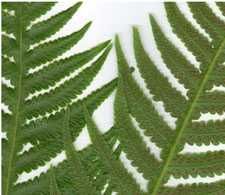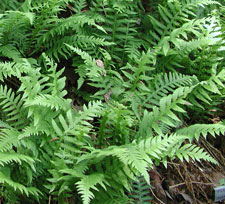Resource Library
Plant of the Week: Winged Beech Fern
The University of Arkansas System Division of Agriculture does not promote, support or recommend plants featured in "Plant of the Week." Please consult your local Extension office for plants suitable for your region.
Plant of the Week
Winged Beech Fern
Latin: Phegopteris decursive-pinnata

Ferns are beguiling and beautiful plants that are a study in green. Because they don’t flower, we can appreciate them for their graceful lines, forms and textures.
As hardy garden ferns have become more commonly available in recent years, I’ve made a point of growing as many species as possible. One of these, the winged or Japanese beech fern, has done well in my Ozark shade garden and should be more widely known.
Fern taxonomy is a muddled and murky business so, not surprisingly, the winged beech fern has several Latin names. The currently accepted correct one - Phegopteris decursive-pinnata - was first used in 1852, but since then others have classified it in no fewer than five other genera. The most common of these synonyms and the one often seen in the nursery trade is Thelypteris decursive-pinnata.
Winged beech fern grows 16 to 24 inches tall with erect, featherlike yellow-green fronds arising from a central clump. The midrib (rachis) has a broad wing running down the length of the blade, a characteristic readily separating it from most other ferns. Plants are deciduous and die down in the winter.
Though winged beech fern forms a dominant central clump, it spreads horizontally by slender, shallow rhizomes that creep outward to form new plants that grow 6 to 10 inches tall their first season.
During midsummer, spores are borne on mature fronds in round, brown, dome-shaped indusia on the lower surface of the pinnae and on the winged appendage attached to the midrib.

The Latin name for this fern translates literally as phegos (beech) and pteris (fern); the epitaph makes reference to the winged appendage down the length of the pinnate frond. This species of beech fern is widely distributed in Asia including Korea, Japan, coastal parts of China and on Taiwan. A related species, but without the conspicuous winged midrib, occurs in the Eastern states, including much of Arkansas.
I have the winged beech fern growing in a bed containing rich potting soil and, in another location, in a heavy mineral soil. Plants in the better soil are taller by half than those in the drier, less fertile site but otherwise seem to be doing well in both locations.
Both plantings have shown signs of spread by the underground rhizomes but, even in the loose, friable potting soil bed plants have spread no more than about 8 inches from the original planting in three years. So, though it will spread, it seems to do so only slowly.
Interestingly though, this is only one of two fern species I have had appear naturally by self-sown spores. It and Japanese painted fern are very easy to grow from spores and will yield transplantable size plants in twelve months.
From my experience winged beech fern is easy to grow and tolerant of a fairly wide range of conditions. It is winter hardy as far north as zone 4. Like most ferns it does best in semishade in a fertile, organic site. It grows taller and more robustly with moist conditions but has moderate drought tolerance.
By: Gerald Klingaman, retired
Extension Horticulturist - Ornamentals
Extension News - September 8, 2006
The University of Arkansas System Division of Agriculture does not maintain lists of retail outlets where these plants can be purchased. Please check your local nursery or other retail outlets to ask about the availability of these plants for your growing area.